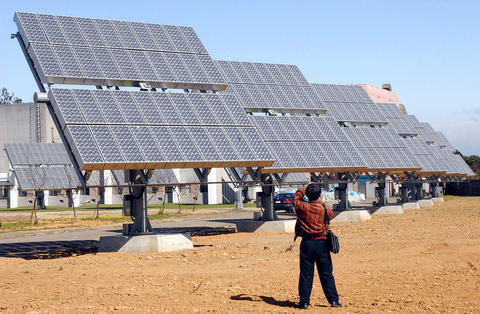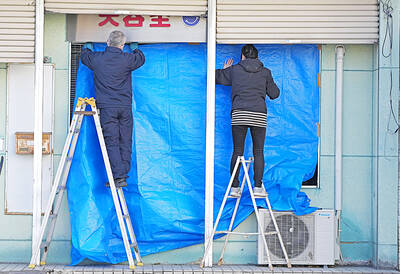From a dopamine-tracing imaging agent capable of accurately diagnosing Parkinson's Disease, to the production of biomass ethanol fuel made from rice straw, the Institute of Nuclear Energy Research (INER) yesterday unveiled its achievements of the past year.
The INER, a branch of the Atomic Energy Council, consists of three key technology centers -- the Nuclear Safety Technology Center (NSTC), the Environmental and Energy Technology Center (EETC) and the Radiation Application Technology Center (RATC) -- the institute's director Yeh Tuan-ran (
"Last year was an eventful year for us," Yeh told a news conference. "The achievements were the fruits of years of hard work and innovation."

PHOTO: AFP
The INER had worked solely in atomic energy and through the NSTC had successfully improved the Second Nuclear Power Plant's efficiency by increasing its annual output by 150 million units of electricity.
Evolving with emerging trends and needs, the INER has expanded its domain of research and development to now focus on areas such as new energy technologies and environmental protection mainly through its EETC arm, he said.
In addition to rice straw biomass fuel, other examples of INER's expanded scope of research included ongoing research and experimentation on wind turbines and the continuing development of III-V solar cells equipped with concentration lenses to maximize efficiency and output, he said.
As the technologies involved are progressive and "in the budding stage in even the most advanced countries," most of the institute's projects require further development, he said.
"However, with sustainability and cost-efficiency in mind, the outcome of these projects should prove extremely helpful to mankind," he said.
The institute's aim for solar energy development is to level its costs with traditional coal-generated energy," said INER director of the nuclear instrumentation division, Kuo Cherng-tsong (郭成聰).
Solar cells, also known as photovoltaic cells, convert solar energy to electricity by the photovoltaic effect, Kuo said.
Concentrating photovoltaic systems consist of large areas of lenses that focus sunlight onto a compact area of photovoltaic cells, he said, adding that the upgraded Heliostat Concentrator Photovoltaics (HCPV) systems employ single or duel-axis tracking to maximize output.
"INER's 100 KW III-V HCPV systems now attain a 32.6 percent fuel efficiency, which is almost on a par with world's best of 40.7 percent," he said.
The institute estimates that when the 40-percent target is achieved, the price of solar energy will be as competitive as coal-generated energy, he said.
"INER is a strong research institute in that it is capable of achieving excellent systems integration." Yeh said. "All of our technologies are developed locally, step by step, and from scratch, making them extremely localized and cost-effective."

Taiwanese were praised for their composure after a video filmed by Taiwanese tourists capturing the moment a magnitude 7.5 earthquake struck Japan’s Aomori Prefecture went viral on social media. The video shows a hotel room shaking violently amid Monday’s quake, with objects falling to the ground. Two Taiwanese began filming with their mobile phones, while two others held the sides of a TV to prevent it from falling. When the shaking stopped, the pair calmly took down the TV and laid it flat on a tatami mat, the video shows. The video also captured the group talking about the safety of their companions bathing

US climber Alex Honnold is to attempt to scale Taipei 101 without a rope and harness in a live Netflix special on Jan. 24, the streaming platform announced on Wednesday. Accounting for the time difference, the two-hour broadcast of Honnold’s climb, called Skyscraper Live, is to air on Jan. 23 in the US, Netflix said in a statement. Honnold, 40, was the first person ever to free solo climb the 900m El Capitan rock formation in Yosemite National Park — a feat that was recorded and later made into the 2018 documentary film Free Solo. Netflix previewed Skyscraper Live in October, after videos

Starting on Jan. 1, YouBike riders must have insurance to use the service, and a six-month trial of NT$5 coupons under certain conditions would be implemented to balance bike shortages, a joint statement from transportation departments across Taipei, New Taipei City and Taoyuan announced yesterday. The rental bike system operator said that coupons would be offered to riders to rent bikes from full stations, for riders who take out an electric-assisted bike from a full station, and for riders who return a bike to an empty station. All riders with YouBike accounts are automatically eligible for the program, and each membership account

A classified Pentagon-produced, multiyear assessment — the Overmatch brief — highlighted unreported Chinese capabilities to destroy US military assets and identified US supply chain choke points, painting a disturbing picture of waning US military might, a New York Times editorial published on Monday said. US Secretary of Defense Pete Hegseth’s comments in November last year that “we lose every time” in Pentagon-conducted war games pitting the US against China further highlighted the uncertainty about the US’ capability to intervene in the event of a Chinese invasion of Taiwan. “It shows the Pentagon’s overreliance on expensive, vulnerable weapons as adversaries field cheap, technologically